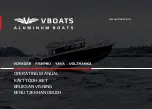
12
Sails and Rigging
Jib/Genoa-
This sail remains hoisted
so the jib halyard should not be removed from the winch.
Stellar J’s jib halyard is a blue line on the winch on the port side of the cabin top. Minor adjustments
in jib luff tension, however, can be made on the winch.
If you accidentally release the jib halyard, make sure to re-tension before furling or unfurling the sail.
It can get jammed up top if there is slack in the halyard while furling.
To unfurl
, first head onto a broad reach to reduce apparent wind. Uncoil
and uncleat furling line which runs from the bow roller to a cam cleat
adjacent the companionway to port.
Make sure to bi-pass this cleat while
unfurling or it will tend to re-cleat itself making unfurling stop
unexpectedly.
Prepare to control the speed of the furl with this line by
taking a single wrap around a winch or cleat as a leverage point. To unfurl,
pull on the working jib sheet. Ease lazy sheet as needed. Ease furling line
slowly to avoid an override in the spool at the bow.
To furl
the headsail- again head onto a broad reach to reduce apparent wind
and allow the sail to furl quietly and smoothly. Ease sheets enough to allow
furling line to start the roll. Keep gentle pressure on both sheets as the
furling line is being hauled in to create an even wrap. Wrap sheets a
minimum of three times around the furl to well secure for winds at the
dock. Secure all lines.
Reefing the roller furling headsail
The
J-80 headsail allows the option of furling the sail to reduce sail area based on wind requirements.
Some sails have black tape lines at desired reef points. Most do not so it is best to look at the sail and
furl to a point where the sail is smooth and does not have creases which can stress the sail fabric. To furl
a sail, ease working jib sheet first, haul in furling line to desired sail size, then re-tension jib sheet.
Fairleads typically will have to be adjusted to accommodate new size.
Roller Furling Headsail
Furler cam cleat











































